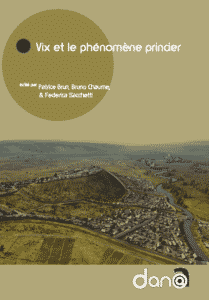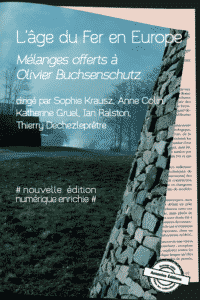UN@ est une plateforme d'édition de livres numériques pour les presses universitaires de Nouvelle-Aquitaine
Auteur : Rüdiger Krause

Goethe-Universität Frankfurt
Institut für Archäologische Wissenschaften
Vor- und Frühgeschichte
Campus Westend
Norbert-Wollheim-Platz 1
D-60629 Frankfurt (Main)
R.Krause@em.uni-frankfurt.de
0000-0002-3432-9715

Institut für Archäologische Wissenschaften
Vor- und Frühgeschichte
Campus Westend
Norbert-Wollheim-Platz 1
D-60629 Frankfurt (Main)
R.Krause@em.uni-frankfurt.de
0000-0002-3432-9715

Rüdiger Krause (born April 3, 1958 in Baghdad) is a German prehistorian and university lecturer. Since 2006 he has been Professor of Prehistory and Early History in Europe at the Johann Wolfgang Goethe University in Frankfurt am Main .
References
- R. Krause, Die endneolithischen und frühbronzezeitlichen Grabfunde auf der Nordstadtterrasse von Singen am Hohentwiel. Grabfunde von Singen am Hohentwiel. Forsch. u. Ber. zur Vor- und Frühgeschichte in Baden-Württemberg 32 (Stuttgart 1988).
- R. Krause, Studien zur kupfer- und frühbronzezeitlichen Metallurgie zwischen Karpatenbecken und Ostsee. Vorgeschichtliche Forschungen 24 (Rahden 2003).
- R. Krause (Hrsg.), Mittelalterlicher Bergbau auf dem Kristberg im Montafon, Vorarlberg (Österreich). Frankfurter Archäologische Schriften 22 (Bonn 2013).
- R. Krause / L. N. Koryakova (eds.), Multidisciplinary investigations of the Bronze Age settlements in the southern Trans-Urals (Russia). Frankfurter Archäologische Schriften 23 (Bonn 2013).
- R. Krause / L. N. Korjakova (eds.), Zwischen Tradition und Innovation. Studien zur Bronzezeit im Trans-Ural (Russische Föderation). Frankfurter Archäologische Schriften 28 (Bonn 2014).
- R. Krause (Hrsg.), Neue Forschungen zum frühkeltischen Fürstensitz auf dem Ipf. Frankfurter Archäologische Schriften 24; Ipf-Forschungen 1 (Bonn 2014).
- R. Krause, Archäologie im Gebirge. Montafoner Zeitmaschine. Frühe Besiedlungsgeschichte und Bergbau im Montafon, Vorarlberg (Österreich) (Bartholomäberg/Bonn 2015).
- R. Krause, Der Ipf. Fürstensitz im Fokus der Archäologie (Stuttgart 2015).
- R. Gebhard / R. Krause, Bernstorf – Archäologisch-naturwissenschaftliche Analysen der Gold- und Bernsteinfunde vom Bernstorfer Berg bei Kranzberg, Oberbayern. Abhandlungen und Bestandskataloge der Archäologischen Staatssammlung, Band 3 (München 2016).
- S. Hansen / R. Krause (eds.), Bronze Age Hillforts between Taunus and Carpathian Mountains. Proceedings of the First International LOEWE Conference, 7-9 December 2016 in Frankfurt/M. Universitätsforschungen zur prähistorischen Archäologie 319 (Bonn 2018).
- S. Hansen / R. Krause (eds.), Bronze Age Fortresses in Europe. Proceedings of the Second International LOEWE Conference, 9-13 October 2017 in Alba Iulia (Romania). Universitätsforschungen prähistorische Archäologie 346, Prähistorische Konfliktforschung 3 (Bonn 2019).
- S. Hansen / R. Krause (eds.), Materialisation of Conflicts. Proceedings of the Third International LOEWE Conference, 24th – 27th September 2018 in Fulda (Hesse, Germany). Universitätsforschungen prähistorische Archäologie 346, Prähistorische Konfliktforschung 4 (Bonn 2019).
- R. Krause (Hrsg.), Archäologische Beiträge zur Bronze- und Eisenzeit auf dem Ipf. Frankfurter Archäologische Schriften 40, Ipf-Forschungen 3 (Bonn 2020).
Geo-Tour – Das Montafon – Auf der Spur des Alpenerzes, février 2021 (© Planet Schule – Wissen & Technik ∙ SWR Fernsehen).
Searching for traces of the Bronze Age (© LOEWE Research Initiatives Network).
Ici comme partout ailleurs, des changements dans l’organisation des habitats sont visibles. Ceux-ci dépendent soit de la durée de l’occupation sur place, ce qui paraît plausible si on soutient l’hypothèse d’un système patriarcal et d’une filiation multiple des familles, soit il s’agit de nouveaux types d’habitat progressistes comme les fermes à enclos rectangulaire dont on attribue un rang plus élevé que celui des fermes groupées en hameau.

par Rüdiger Krause
The renown of Mount Ipf extends far beyond the boundaries of southern Germany as an important archaeological monument belonging to the cultural sphere of early Celtic ‘princely seats’ in central Europe. Recent archaeological discoveries on Mount Ipf and in its surroundings have contributed substantially to research on the Iron Age in Europe. In 2000, after an interval of almost one hundred years, comprehensive and interdisciplinary research and excavations began again on Mount Ipf. The results of investigations have made it clear that the fortress on Mount Ipf held the exceptional position as an important centre of power in the Nördlinger Ries (located on the border between Baden-Württemberg and Bavaria). In the sixth/fifth centuries BC, during the late Hallstatt and early La Tène period, this fortified hilltop settlement belonged to the sphere of early Celtic ‘princely seats’ in central Europe. Through its central location it maintained direct relations via the Alps with the Mediterranean world.


